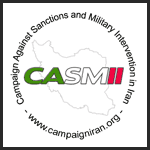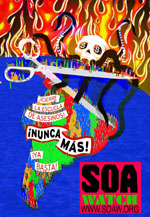The BBC report (h/t Rafael) on the publication of the official record of atrocities performed by the right wing military dictatorship of Brazil. Good on them, except, they don’t mention it was right wing (ok so people assume that perhaps, but what about those not so savvy?) but … well you can read the article at the bottom of this list of School of the America Graduates who staffed the repressive forces. See strangely the BBC forgot to mention America’s role in Brazil’s right wing military dictatorship, how ironic for a report on a document entitled ‘The Right to Memory and to Truth’ sarcastic, moi? (oh and a corruption scandal hogs the news about Brazil so this story got reported in single figures while the administration’s corruption problems becomes the story in the mainstream sphere)-
Bismarck Baracuhy Amancio Ramalho, 1967, Military Intelligence, Phase II
Repressive Forces: According to the Brazilian human rights group
Tortura Nunca Mais, he is linked to the repressive forces that existed
in Brazil in the 1960’s and 70’s. (Tortura Nunca Mais)Mauro Baptista Lobo, 1967, Counterintelligence
Repressive Forces: According to the Brazilian human rights group
Tortura Nunca Mais, he is linked to the repressive forces that existed
in Brazil in the 1960’s and 70’s. (Tortura Nunca Mais)
Carlos Alberto Bravo da Camara, 1967, Military Intelligence Phase I;
1967, Counterintelligence Off.
Repressive Forces: According to the Brazilian human rights group
Tortura Nunca Mais, he is linked to the repressive forces that existed
in Brazil in the 1960’s and 70’s. (Tortura Nunca Mais)SGT Sergio Mazza de Azevedo, 1968, Combat Intelligence; 1968, Advanced
Auto Repair
Repressive Forces: According to the Brazilian human rights group
Tortura Nunca Mais, he is linked to the repressive forces that existed
in Brazil in the 1960’s and 70’s. (Tortura Nunca Mais)Joao Flavio de Freitas Costa, 1967, Counterintelligence
Repressive Forces: According to the Brazilian human rights group
Tortura Nunca Mais, he is linked to the repressive forces that existed
in Brazil in the 1960’s and 70’s. (Tortura Nunca Mais)CPT Luiz de Souza Aguiar, 1959, Military Police Officer
Repressive Forces: According to the Brazilian human rights group
Tortura Nunca Mais, he is linked to the repressive forces that existed
in Brazil in the 1960’s and 70’s. (Tortura Nunca Mais)Ubirajara Escorcio, 1968, Combat Intelligence
Repressive Forces: According to the Brazilian human rights group
Tortura Nunca Mais, he is linked to the repressive forces that existed
in Brazil in the 1960’s and 70’s. (Tortura Nunca Mais)Jose Gomes da Silva, 1969, Military Police
Repressive Forces: According to the Brazilian human rights group
Tortura Nunca Mais, he is linked to the repressive forces that existed
in Brazil in the 1960’s and 70’s. (Tortura Nunca Mais)1LT Jose Lamas Portugal,1990, Instructor
Repressive Forces: According to the Brazilian human rights group
Tortura Nunca Mais, he is linked to the repressive forces that existed
in Brazil in the 1960’s and 70’s. (Tortura Nunca Mais)GEN Helio Lima Ibiapina,1966, Military Intelligence, Phase I
Torture, 1969: Accused by Gregorio Bezerra of false imprisonment and
torture. (Tortura Nunca Mais)Altevir Lopes, 1960, Military Police Officer
Repressive Forces: According to the Brazilian human rights group
Tortura Nunca Mais, he is linked to the repressive forces that existed
in Brazil in the 1960’s and 70’s. (Tortura Nunca Mais)CPT Paulo Magalhaes, 1959, Military Police Officer
Torture, 1969: Accused in a military court by students Sergio Ubiratan
Manes and Paulo Roberto Manes of torturing them. (Tortura Nunca Mais)Francisco Renato Mello, 1967, Military Intelligence, Phase I
Repressive Forces: According to the Brazilian human rights group
Tortura Nunca Mais, he is linked to the repressive forces that existed
in Brazil in the 1960’s and 70’s. (Tortura Nunca Mais)CDR. Clemente Jos? Monteiro Filho, 1965, Military Intelligence
Torture, 1969: Accused in military court by the following persons of
torture by various methods, including electric shock: Humberto Trigeiros
Lima, ina de Souza Medeiros, Marta Maria Kagsburnn, Marta Mota Lima
Alavarez, Sebastiao Medeiros Filho and Luis Carlos de Souza Santos.
(Tortura Nunca Mais)Joao Paulo Moreira Burnier, 1967, Military Intelligence, Phase 1
Torture and Execution, 1971: Accused in military court by political
prisoner Alex Polari de Alverga of torturing and killing Stuart Edgard
Angel Jones. (Tortura Nunca Mais)Clodoaldo Paes Cabral, 1970, Inteligencia Militar para Alistados
Repressive Forces: According to the Brazilian human rights group
Tortura Nunca Mais, he is linked to the repressive forces that existed
in Brazil in the 1960’s and 70’s. (Tortura Nunca Mais)Paulo Scholoenback Rubens, 1970, Inteligencia Militar para Oficiales
Repressive Forces: According to the Brazilian human rights group
Tortura Nunca Mais, he is linked to the repressive forces that existed
in Brazil in the 1960’s and 70’s. (Tortura Nunca Mais)Walfrido Silva, 1964, Jungle Operations
Repressive Forces: According to the Brazilian human rights group
Tortura Nunca Mais, he is linked to the repressive forces that existed
in Brazil in the 1960’s and 70’s. (Tortura Nunca Mais)CPT. Lucio Valle Barroso, 1970, Military Intelligence for Officers
Torture, 1971: Accused in military court by political prisoner Alex
Polari de Alverga of torture by electric shock, suffocation, and
injection of pentothal. (Tortura Nunca Mais)Thaumaturgo Sotero Voz, 1962, CIO
Torture, 1972: Accused in court by ex-political prisoner Danilo Carneiro
of personally torturing him. (Tortura Nunca Mais)Moyses Thompson do Nascimento, 1972, Instructor
Repressive Forces: According to the Brazilian human rights group
Tortura Nunca Mais, he is linked to the repressive forces that existed
in Brazil in the 1960’s and 70’s. (Tortura Nunca Mais)
Brazil has for the first time published an official document detailing atrocities said to have been committed during the military dictatorship. The country was under military control from 1964 to 1985.
The book was launched at a ceremony attended by President Luiz Inacio Lula da Silva, who was himself briefly imprisoned under the dictatorship It accuses federal agents of rape, torture, executing prisoners, and concealing bodies of victims. They are also alleged to have decapitated people.
The new book, “The Right to Memory and to Truth”, was published on the anniversary of Brazil’s amnesty law passed in 1979. That law, passed as the dictatorship was drawing to a close, pardoned all those said to have been involved in crimes committed under the regime, as well as those who fought against it.
After 11 years of work, this official publication is meant to record what the special commission set up to investigate political deaths and disappearances considers to be the historical truth about this dark period in Brazil’s recent history. More than 400 people are believed to have been killed under military rule, while more than 160 others are thought to have disappeared, although this was far fewer than in neighbouring countries such as Chile and Argentina.
The book also notes that opponents of the regime resorted to bank robberies, kidnappings of foreign diplomats and attacks on military bases, which it says produced countless victims.
Paulo Vannuchi, Brazil’s special secretary for human rights, speaking at the launch of the book, told the BBC he would not use the word “crime” to describe the deaths of agents working for the dictatorship – a view that is likely to cause anger in military circles. Mr Vannuchi was a member of a militant group that fought against the regime and was imprisoned for five years, during which he was tortured.
In 1995, Brazil passed a law acknowledging the government was responsible for deaths under the dictatorship and compensation was paid to more than 300 families. However, the bodies of some of those who disappeared have not been recovered and the book calls on the government to allow for evidence to be taken from members of the police and military who might be able to locate those missing remains.
Victims of the dictatorship say because of this the official publication only represents modest progress, while the authors say they hope it will advance the sacred right of families to bury their loved ones.



















